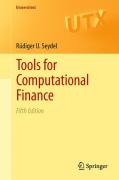
The disciplines of financial engineering and numerical computation differ greatly, however computational methods are used in a number of ways across the field of finance. It is the aim of this book to explain how such methods work infinancial engineering; specifically the use of numerical methods as tools forcomputational finance. By concentrating on the field of option pricing, a core task of financial engineering and risk analysis, this book explores a wide range of computational tools in a coherent and focused manner and will be of use to the entire field of computational finance. Starting with an introductory chapter that presents the financial and stochastic background, the remainder of the book goes on to detail computational methods using both stochastic and deterministic approaches.Now in its fifth edition, Tools for Computational Finance has been significantly revised and contains:.A new chapter on incomplete markets which links to new appendices on Viscosity solutions and the Dupire equation;Several new parts throughout the book such as that on the calculation ofsensitivities (Sect. 3.7) and the introduction of penalty methods and their application to a two-factor model (Sect. 6.7)Additional material in the field of analytical methods including Kim's integral representation and its computationGuidelines for comparing algorithms and judging their efficiencyAn extended chapter on finite elements that now includes a discussion of two-asset optionsAdditional exercises, figures and referencesWritten from the perspective of anapplied mathematician, methods are introduced as tools within the book for immediate and straightforward application. A '˜learning by calculating' approachis adopted throughout this book enabling readers to explore several areas of the financial world.Interdisciplinary in nature, this book will appeal to advanced undergraduate students.
- ISBN: 978-1-4471-2992-9
- Editorial: Springer
- Encuadernacion: Rústica
- Fecha Publicación: 14/03/2012
- Nº Volúmenes: 1
- Idioma: Inglés
